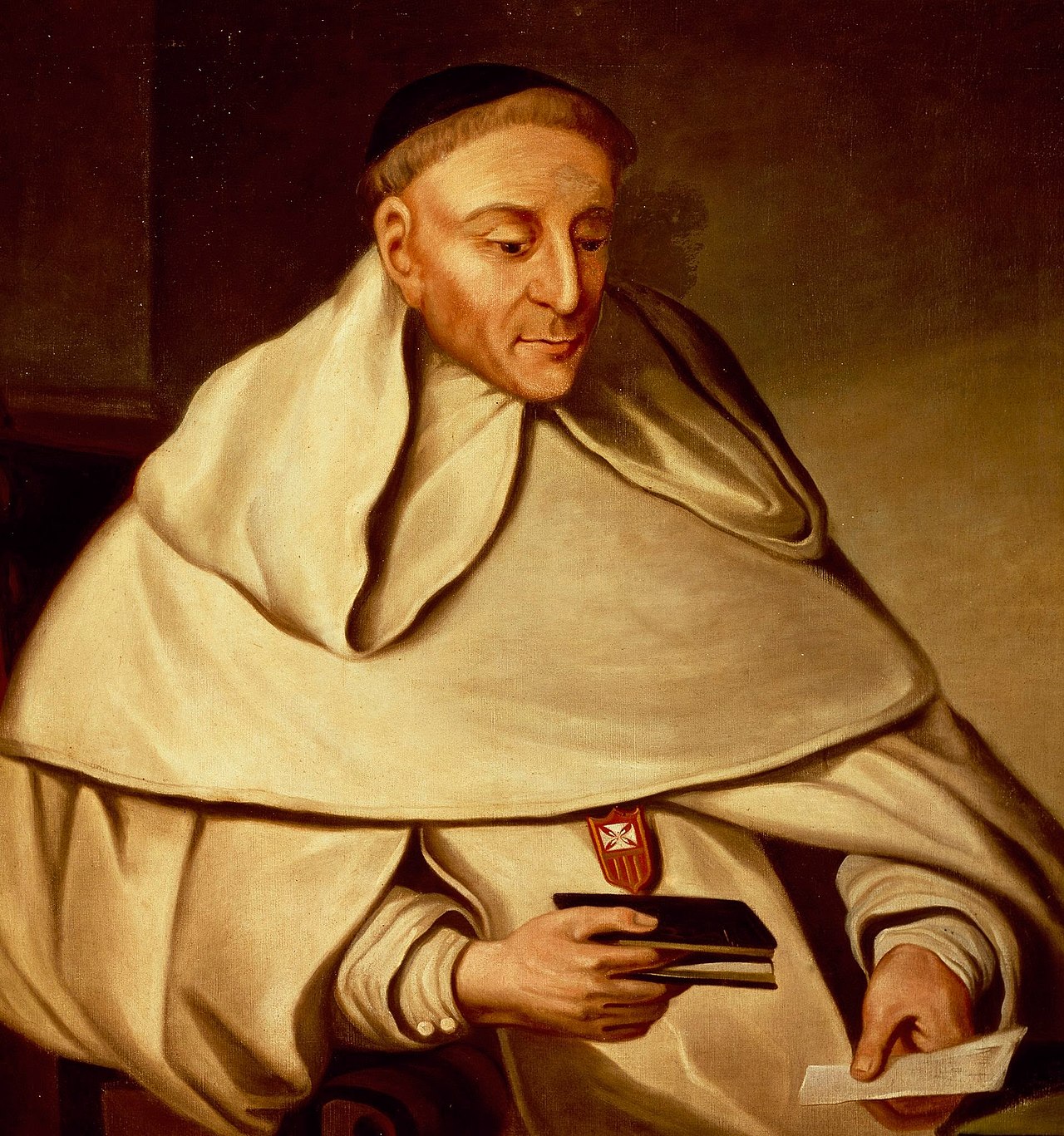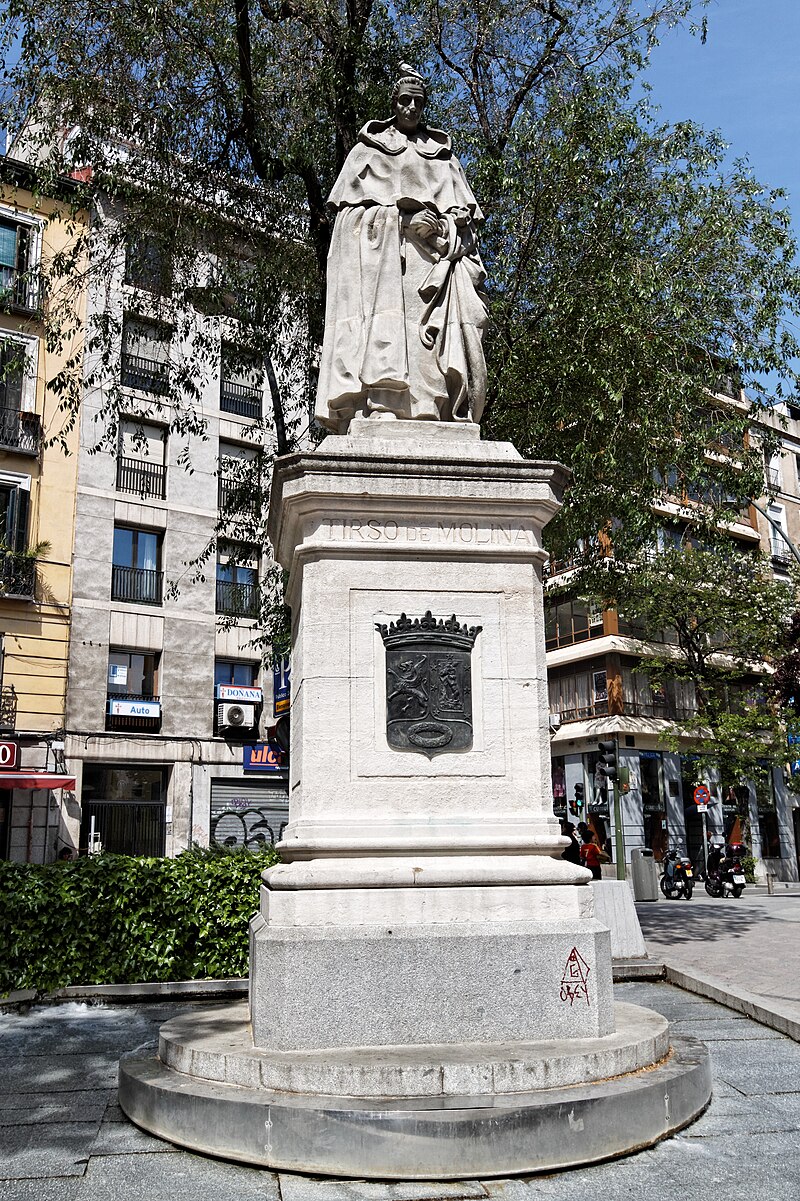
ティルソ・デ・モリーナ
Gabriel Téllez, or Tirso de Molina,
1583-1648

☆ ガブリエル・テレス(Gabriel Téllez, 1583年3月24日頃 - 1648年2月20日頃)は、ティルソ・デ・モリナ(Tirso de Molina)としても知られるスペインのバロック 劇作家、詩人、ローマ・カトリック修道士である。主に『セビリアのいたずら者と石の客』の作者として知られる。ティルソ・デ・モリーナは劇作家として特に有名である。彼の劇作家としての主な作品には、"Don Gil de las calzas verdes"のようないたずら喜劇や、"La Santa Juana"や "La dama del olivar"の3部作のような寓話的作品がある。彼は伝統的にEl burlador de Sevillaの ドン・ファン神話を創作したとされており、その最初のバージョンは1617年で、17世紀にカルデロンの名前で出版され、アンドレス・デ・クララモンテの 作とする戯曲Tan largo me lo fiaisがある(ただし、ティルソが1612年から1625年の間に書いた共通の原型に関連したバージョンとする他の批評家はいない)。前述の戯曲で は、セビリア貴族のドン・ファンが、目の前に現れた多くの女性を辱めることで社会秩序を乱し、最後に犠牲者の一人である嘲笑された女性の父親の葬儀像に よって罰せられ、殺され地獄に引きずり込まれる。神賊の喜劇『El condenado por desconfiado』の作者についても議論がある。ティルソは、彼の文学作品の主人公となった女性キャラクターに心理的深みを与えた最初の作家であ る。
| Gabriel Téllez (c.
24 March 1583 – c. 20 February 1648),[1] also known as Tirso de Molina,
was a Spanish Baroque dramatist, poet, and Roman Catholic monk. He is
primarily known for writing The Trickster of Seville and the Stone
Guest, the play from which the character Don Juan originates.[2] His
work also includes female protagonists and the exploration of sexual
issues.[3] https://en.wikipedia.org/wiki/Tirso_de_Molina +++++++++++++++++++ Tirso de Molina (seudónimo de fray Gabriel Téllez; Madrid, 24 de marzo de 1579-Almazán, hacia el 20 de febrero de 1648) fue un religioso mercedario español que destacó como dramaturgo, poeta y narrador del Barroco. Tirso de Molina destaca sobre todo como autor dramático. Su dramaturgia abarca principalmente la comedia de enredo, como Don Gil de las calzas verdes, y obras hagiográficas como la trilogía de La Santa Juana o La dama del olivar. Se le ha atribuido tradicionalmente la creación del mito de Don Juan en El burlador de Sevilla, cuya primera versión podría ser de 1617, con la obra Tan largo me lo fiais, editada en el siglo xvii a nombre de Calderón y que parte de la crítica atribuye a Andrés de Claramonte (no así otro sector de críticos, que la tienen como una versión emparentada con un arquetipo común escrito por Tirso entre 1612 y 1625); en la citada obra, Don Juan, un noble sevillano, altera el orden social deshonrando a cuantas mujeres se le ponen delante y finalmente es castigado por la estatua funeraria de una de sus víctimas, el padre de una de las damas burladas, que lo mata y lo arrastra a los infiernos. También se encuentra en discusión la autoría de El condenado por desconfiado, comedia de bandoleros a lo divino. Tirso fue el primer autor que dio profundidad psicológica a los personajes femeninos, que llegaron a ser protagonistas de sus obras literarias. https://es.wikipedia.org/wiki/Tirso_de_Molina |
ガブリエル・テレス(Gabriel Téllez,
1583年3月24日頃 - 1648年2月20日頃)は、ティルソ・デ・モリナ(Tirso de
Molina)としても知られるスペインのバロック
劇作家、詩人、ローマ・カトリック修道士である。主に『セビリアのいたずら者と石の客』の作者として知られる。 https://en.wikipedia.org/wiki/Tirso_de_Molina +++++++++++++++++++ ティルソ・デ・モリナ(ガブリエル・テレス修道士のペンネーム、マドリード、1579年3月24日-アルマザン、1648年2月20日頃)は、スペインの メルセダリア修道士で、バロックの 劇作家、詩人、ストーリーテラーとして優れた才能を発揮した。 ティルソ・デ・モリーナは劇作家として特に有名である。彼の劇作家としての主な作品には、"Don Gil de las calzas verdes"のようないたずら喜劇や、"La Santa Juana"や "La dama del olivar"の3部作のような寓話的作品がある。彼は伝統的にEl burlador de Sevillaの ドン・ファン神話を創作したとされており、その最初のバージョンは1617年で、17世紀にカルデロンの名前で出版され、アンドレス・デ・クララモンテの 作とする戯曲Tan largo me lo fiaisがある(ただし、ティルソが1612年から1625年の間に書いた共通の原型に関連したバージョンとする他の批評家はいない)。前述の戯曲で は、セビリア貴族のドン・ファンが、目の前に現れた多くの女性を辱めることで社会秩序を乱し、最後に犠牲者の一人である嘲笑された女性の父親の葬儀像に よって罰せられ、殺され地獄に引きずり込まれる。神賊の喜劇『El condenado por desconfiado』の作者についても議論がある。ティルソは、彼の文学作品の主人公となった女性キャラクターに心理的深みを与えた最初の作家であ る。 https://es.wikipedia.org/wiki/Tirso_de_Molina |
| Life and career Gabriel Téllez was born in Madrid. He studied at Alcalá de Henares. He joined the mendicant Order of the Blessed Virgin Mary of Mercy on 4 November 1600, and entered the Monastery of San Antolín at Guadalajara, Spain on 21 January 1601. He had been ordained as a priest by 1610.[4] He had been writing plays for ten years when he was sent by his superiors on a mission to the West Indies in 1615; as a result, he resided in Santo Domingo from 1616 to 1618. After returning to Europe in 1618, he resided at the Mercedarian monastery in Madrid, took part in the proceedings of the Academia Poética de Madrid, competed in the literary tournaments, and wrote for the stage.[5] His first publication, the incomplete Cigarrales de Toledo (a work licensed in 1621, but not published until 1624), is a miscellany of short tales, novellas, verses, and three plays. One of the novellas, Los tres maridos burlados, which may have been derived from Francesco Cieco da Ferrara's Mambriano, and the play entitled El vergonzoso en palacio are considered to demonstrate wit and ingenuity.[citation needed] The preface to Cigarrales de Toledo states that Tirso de Molina had already written three hundred plays. He opposed culteranismo in the Cigarrales de Toledo, and made enemies through his attacks on it in pieces such as Amar por arte mayor and La celosa de si misma. The tone of some of his productions caused his rivals to denounce him as a corrupter of public morals to the council of Castile in 1625, and, though no legal action was taken against him, he may have been reprimanded privately. In 1626, it was thought to be advisable to transfer him to Salamanca, and Tirso de Molina left Madrid, determined to not write more for the stage. Although one of his plays, La huerta de San Juan, is dated as being written in 1626, there is no proof that he started writing it after his departure from Madrid, and it is suspected that he did not write anything for eight years.[5] He had not lost his interest in theatre, having published twelve representative pieces as the first part of his dramatic works (1626). At the same time, he worked on the behalf of his order, causing him to become the superior of the monastery at Trujillo in 1626; he was elected later to the posts of reader in theology and definidor general[further explanation needed], and in May 1632, he was appointed as chronicler of the Order of Mercy. His Deleitar aprovechando (1635) is a counterpart of the Cigarrales de Toledo; a sequel was promised to this collection of tales, lyrics, and autos, but, as in the case of the Cigarrales de Toledo, the continuation never appeared.[5] Twelve plays constitute the third part of his dramatic works published in 1634; the plays were supposedly edited by the writer's nephew, Francisco Lucas de Ávila; however, Ávila may have been a cover identity for himself. The second section of the plays (1635), the printing of which was paid for by the confraternity of St Jerome, contains four plays by Tirso de Molina, and eight written by him in collaboration with other dramatists, including Juan Ruiz de Alarcón; however, Tirso de Molina still did the majority of the writing. The fourth and fifth compilations of his dramatic works (1635 and 1636) each contain twelve plays; the haste with which these five volumes were issued may indicate the author's desire to save some part of his work from destruction, and the appearance of his nephew's name on the titlepages of the last four volumes may indicate his desire to avoid conflict with the authorities. A sixth volume of dramatic pieces, consisting of comedies, was announced; however, the project was abandoned. Dramatic composition may have still been a part of Tirso's leisure as his age increased, as indicated by how the fragmentary autograph copy of Las quinas de Portugal is dated 8 March 1638, despite the fact that his active career as a dramatist ended two years earlier. He was absorbed by other duties. As official chronicler of his order, he compiled the elaborate Historia de la Merced (his religious order), which occupied him until 24 December 1639, and which was not published until 1973. As a tribute to the count de Sastago, who had accepted the dedication of the fourth part of the plays, and who may have helped to defray the publishing expenses, Tirso de Molina is said to have compiled the Genealogía de la casa de Sastago (1640), but the ascription of this genealogical work is disputed. On 29 September 1645, Tirso de Molina became the superior of the monastery at Soria, where he died.[5] |
生涯とキャリア[編集] ガブリエル・テレスはマドリードで生まれた。アルカラ・デ・エナレスで学ぶ。1600年11月4日に慈悲の聖母マリア托鉢修道会に入会し、1601年1月 21日にスペインのグアダラハラにあるサン・アントリン修道院に入った。1610年には司祭に叙階されていた[4]。 1615年に西インド諸島への使節団に派遣され、1616年から1618年までサント・ドミンゴに滞在した。1618年にヨーロッパに戻ると、マドリード のメルセダリア修道院に滞在し、マドリード詩アカデミーの議事に参加し、文学トーナメントに出場し、舞台のために執筆した[5]。 彼の最初の出版物である未完の『トレドのシガラレス』(1621年に出版許可されたが、1624年まで出版されなかった)は、短い物語、小説、詩、3つの 戯曲から成る雑多な作品である。フランチェスコ・チエコ・ダ・フェラーラの『マンブリアーノ』に由来すると思われる短編小説『三人の結婚者たち』(Los tres maridos burlados)と、『宮廷のヴェルゴンゾーソ』(El vergonzoso en palacio)と題された戯曲は、機知と独創性を示していると考えられている[要出典]。『シガラル・デ・トレド』の序文には、ティルソ・デ・モリーナ がすでに300本の戯曲を書いていたと書かれている。 ティルソ・デ・モリーナは、『シガラル・デ・トレド』の中でカルテラニズムに反対し、『アマール・ポル・アルテ・マヨール』や『ラ・セロサ・デ・シ・ミス マ』などの作品でカルテラニズムを攻撃して敵を作った。1625年、彼のライバルたちがカスティーリャ議会に、風紀を乱す者として彼を糾弾した。1626 年、ティルソ・デ・モリーナはサラマンカに移されることが望ましいと考えられ、これ以上舞台作品を書くまいと決意してマドリードを去った。彼の戯曲のひと つであるLa huerta de San Juanは1626年に書かれたことになっているが、マドリードを離れてから書き始めたという確証はなく、8年間は何も書かなかったのではないかと疑われ ている[5]。 演劇への関心は失っておらず、代表的な12の作品を劇作の第一部として出版している(1626年)。同時に、修道会のために働き、1626年にはトルヒー ヨの修道院の院長となった。その後、神学の読者やデフィニドール・ジェネラルのポストに選ばれ[さらに説明が必要]、1632年5月には慈悲の修道会の記 録係に任命された。Deleitar aprovechando』(1635年)は、『シガラル・デ・トレド』と対をなすものである。この物語、歌詞、自作のコレクションには続編が約束されて いたが、『シガラル・デ・トレド』の場合と同様、続編は現れなかった[5]。 12編の戯曲は、1634年に出版された戯曲集第3部を構成している。この戯曲集は、作家の甥フランシスコ・ルーカス・デ・アビラが編集したとされている が、アビラは彼自身の偽装であった可能性もある。戯曲の第二部(1635年)は、聖ジェローム修道会が印刷費を負担し、ティルソ・デ・モリーナによる4つ の戯曲と、フアン・ルイス・デ・アラルコンを含む他の劇作家との共作による8つの戯曲が収録されている。第4巻と第5巻(1635年と1636年)には、 それぞれ12の戯曲が収められている。この5巻が急いで発行されたのは、自分の作品の一部を破壊から救いたいという作者の願望を表しているのかもしれない し、最後の4巻のタイトルページに甥の名前があるのは、当局との対立を避けたいという作者の願望を表しているのかもしれない。喜劇からなる戯曲の第6巻が 発表されたが、この計画は頓挫した。ティルソの年齢が上がっても、戯曲の創作はティルソの余暇の一部であったかもしれない。このことは、『ポルトガルの戯 曲(Las quinas de Portugal)』の断片的な自筆稿の日付が1638年3月8日となっていることからもわかる。彼は他の仕事に没頭していた。修道会の公式記録係とし て、彼は1639年12月24日まで精巧な『Historia de la Merced』(修道会の歴史)を編纂し、1973年まで出版されなかった。ティルソ・デ・モリーナは、戯曲第4部の献呈を引き受けたサスターゴ伯爵への オマージュとして、また出版費用を捻出するために、『サスターゴ家の系図』(1640年)を編纂したと言われているが、この系図著作の帰属については異論 がある。1645年9月29日、ティルソ・デ・モリーナはソリアの修道院の院長となり、そこで亡くなった[5]。 |
Legacy Monument to Tirso de Molina in Madrid (R. Vela, 1943) It is only within the last century that it has become possible to give an outline of his life and only a fraction of his plays have been preserved. The earliest of his extant pieces is dated 1605; in 1624, he had written three hundred plays, and in 1634, he stated that he had composed four hundred within the previous twenty years; however, not more than eighty of his plays are currently in existence. Tirso de Molina is known as the author of The Trickster of Seville and the Stone Guest, the piece in which Don Juan is first presented onstage. However, whether or not other works are correctly attributed to him is disputed; as thought by scholars such as Fernando Cantalapiedra and Alfredo Rodríguez, El Burlador de Sevilla and El Condenado por desconfiado may have been written by Andrés de Claramonte. His works cover multiple genres and scenarios. El Condenado por desconfiado describes a philosophical enigma, while Prudence in Woman is a historical interpretation. Averígüelo Vargas and La villana de Vallecas (The Peasant Woman of Vallecas) write about female characters.[5] His reputation may have extended beyond the Pyrenees in his own lifetime, as indicated by how James Shirley's Opportunity is derived from El Castigo del penséque; however, his name was almost forgotten until the end of the 18th century, when some of his pieces were recast by Dionisio Solis and later by Juan Carretero.[5] The height of his fame occurred between 1839 and 1842, when an incomplete edition of his plays was published by Juan Eugenio Hartzenbusch. He is now accepted as one of the greatest dramatists of Spain.[5] In 2012, Tirso's Condenado por Desconfiado was performed as Damned by Despair at the Olivier Theatre in London, in a new version by Frank McGuinness.[6] |
遺産[編集] マドリードにあるティルソ・デ・モリーナの記念碑(R.ベラ、1943年) ティルソ・デ・モリーナの生涯の概略を知ることができるようになったのはここ1世紀のことであり、戯曲はごく一部しか残っていない。現存する最も古い作品 は1605年のもので、1624年には300の戯曲を書き、1634年にはそれまでの20年間に400の戯曲を書いたと述べている。ティルソ・デ・モリー ナは、ドン・ファンが初めて舞台に登場する作品『セビリアの詐欺師』と『石の客』の作者として知られている。フェルナンド・カンタラピエドラ (Fernando Cantalapiedra)やアルフレド・ロドリゲス(Alfredo Rodríguez)といった研究者が考えているように、『セビリアのブルラドール(El Burlador de Sevilla)』や『コンデナードの脱落者(El Condenado por desconfiado)』はアンドレス・デ・クララモンテ(Andrés de Claramonte)が書いた可能性がある。 彼の作品は複数のジャンルとシナリオにまたがっている。ElCondenado por desconfiado』は哲学的な謎を描き、『Prudence in Woman』は歴史的な解釈である。Averígüelo Vargas』と『La villana de Vallecas(バジェカスの農婦)』は女性の登場人物を描いている[5]。 ジェームズ・シャーリーの『機会』がEl Castigo del penséqueに由来していることからもわかるように、彼の名声は彼自身が生きていた時代にはピレネー山脈を越えて広がっていたかもしれないが、18世 紀末に彼の作品の一部がディオニシオ・ソリスや後にフアン・カレテロによって再演されるまで、彼の名前はほとんど忘れられていた[5]。 彼の名声が最高潮に達したのは1839年から1842年にかけてで、フアン・エウジェニオ・ハルツェンブッシュによって彼の戯曲の不完全版が出版された。 現在では、スペインで最も偉大な劇作家の一人として受け入れられている[5]。 2012年、ティルソの『Condenado por Desconfiado』は、フランク・マクギネスによる新バージョンで、ロンドンのオリヴィエ・シアターで『Damned by Despair』として上演された[6]。 |
| Bibliography Tirso De Molina Bedrageren Fra Sevilla Og Stengæsten [El Burlador de Sevilla y Convidado de Piedra]ISBN 9788792510389 Comedias escogidas[7] Comedias[8] El Teatro del Maestro Tirso de Molina[9] Tirso de Molina; investigaciones bio-bibliográficas[10] Estudios de crítica literaria[11] Discurso ante la Real Academía española[12] El Condenado por desconfiado[13] and "Más sobre las fuentes del Condenado por desconfiado"[14] Etudes sur l'Espagne[15] |
|
| https://en.wikipedia.org/wiki/Tirso_de_Molina |
|
リ ンク
文 献
そ の他の情報
Copyleft, CC, Mitzub'ixi Quq Chi'j, 1996-2099
☆
 ☆
☆